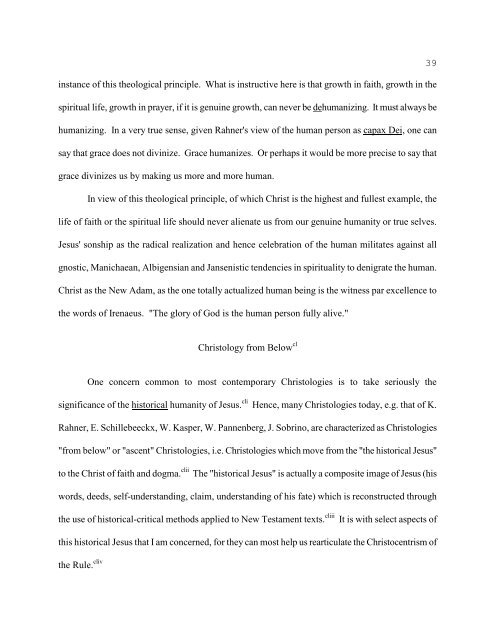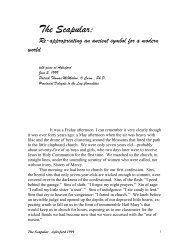Christocentrism of Charism – Buggert - CarmelStream
Christocentrism of Charism – Buggert - CarmelStream
Christocentrism of Charism – Buggert - CarmelStream
You also want an ePaper? Increase the reach of your titles
YUMPU automatically turns print PDFs into web optimized ePapers that Google loves.
instance <strong>of</strong> this theological principle. What is instructive here is that growth in faith, growth in the<br />
spiritual life, growth in prayer, if it is genuine growth, can never be dehumanizing. It must always be<br />
humanizing. In a very true sense, given Rahner's view <strong>of</strong> the human person as capax Dei, one can<br />
say that grace does not divinize. Grace humanizes. Or perhaps it would be more precise to say that<br />
grace divinizes us by making us more and more human.<br />
In view <strong>of</strong> this theological principle, <strong>of</strong> which Christ is the highest and fullest example, the<br />
life <strong>of</strong> faith or the spiritual life should never alienate us from our genuine humanity or true selves.<br />
Jesus' sonship as the radical realization and hence celebration <strong>of</strong> the human militates against all<br />
gnostic, Manichaean, Albigensian and Jansenistic tendencies in spirituality to denigrate the human.<br />
Christ as the New Adam, as the one totally actualized human being is the witness par excellence to<br />
the words <strong>of</strong> Irenaeus. "The glory <strong>of</strong> God is the human person fully alive."<br />
Christology from Below cl<br />
One concern common to most contemporary Christologies is to take seriously the<br />
significance <strong>of</strong> the historical humanity <strong>of</strong> Jesus. cli Hence, many Christologies today, e.g. that <strong>of</strong> K.<br />
Rahner, E. Schillebeeckx, W. Kasper, W. Pannenberg, J. Sobrino, are characterized as Christologies<br />
"from below" or "ascent" Christologies, i.e. Christologies which move from the "the historical Jesus"<br />
to the Christ <strong>of</strong> faith and dogma. clii The "historical Jesus" is actually a composite image <strong>of</strong> Jesus (his<br />
words, deeds, self-understanding, claim, understanding <strong>of</strong> his fate) which is reconstructed through<br />
the use <strong>of</strong> historical-critical methods applied to New Testament texts. cliii It is with select aspects <strong>of</strong><br />
this historical Jesus that I am concerned, for they can most help us rearticulate the <strong>Christocentrism</strong> <strong>of</strong><br />
the Rule. cliv<br />
39



